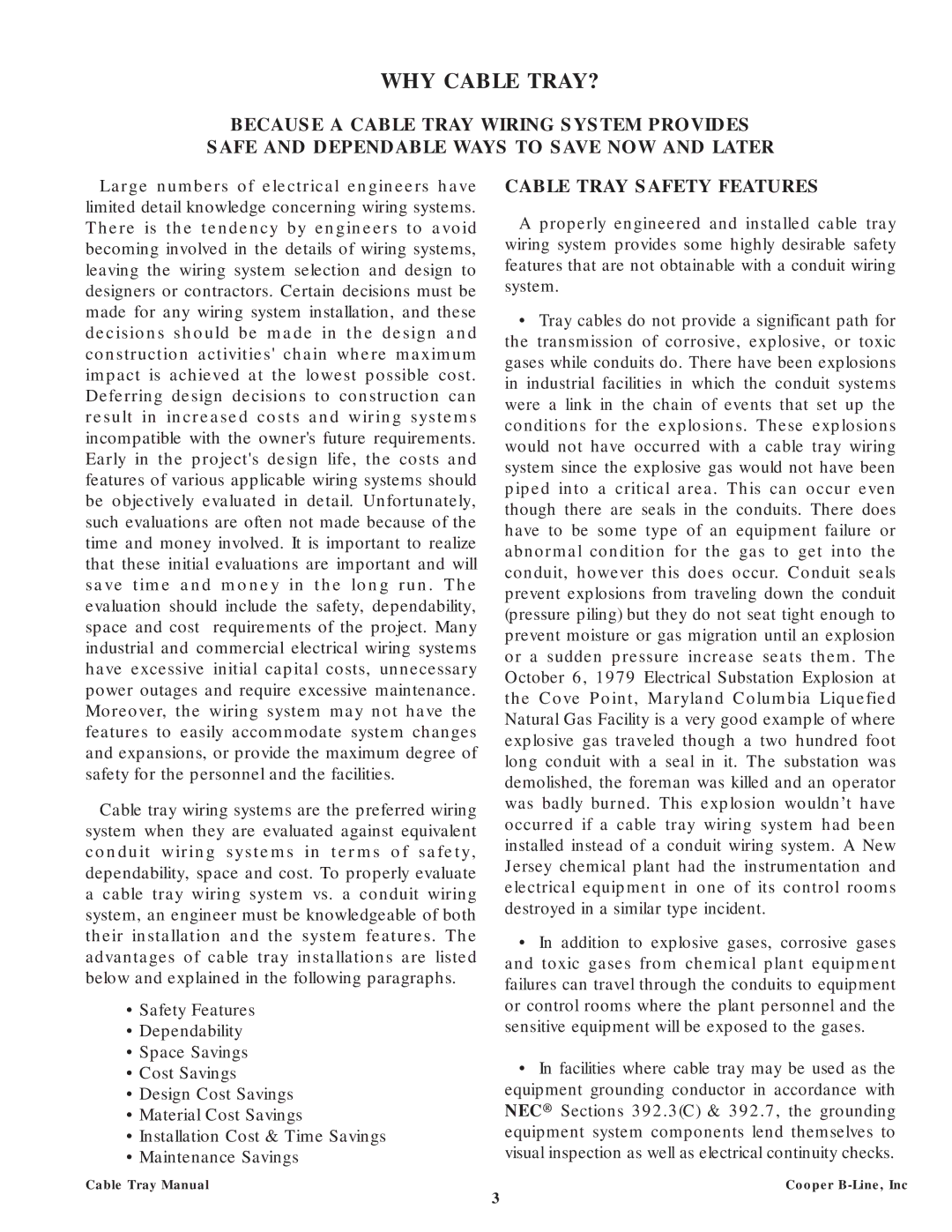WHY CABLE TRAY?
BECAUSE A CABLE TRAY WIRING SYSTEM PROVIDES
SAFE AND DEPENDABLE WAYS TO SAVE NOW AND LATER
Large numbers of electrical engineers have limited detail knowledge concerning wiring systems. There is the tendency by engineers to avoid becoming involved in the details of wiring systems, leaving the wiring system selection and design to designers or contractors. Certain decisions must be made for any wiring system installation, and these decisions should be made in the design and construction activities' chain where maximum impact is achieved at the lowest possible cost. Deferring design decisions to construction can result in increased costs and wiring systems incompatible with the owner's future requirements. Early in the project's design life, the costs and features of various applicable wiring systems should be objectively evaluated in detail. Unfortunately, such evaluations are often not made because of the time and money involved. It is important to realize that these initial evaluations are important and will save time and money in the long run. The evaluation should include the safety, dependability, space and cost requirements of the project. Many industrial and commercial electrical wiring systems have excessive initial capital costs, unnecessary power outages and require excessive maintenance. Moreover, the wiring system may not have the features to easily accommodate system changes and expansions, or provide the maximum degree of safety for the personnel and the facilities.
Cable tray wiring systems are the preferred wiring system when they are evaluated against equivalent conduit wiring systems in terms of safety, dependability, space and cost. To properly evaluate a cable tray wiring system vs. a conduit wiring system, an engineer must be knowledgeable of both their installation and the system features. The advantages of cable tray installations are listed below and explained in the following paragraphs.
•Safety Features
•Dependability
•Space Savings
•Cost Savings
•Design Cost Savings
•Material Cost Savings
•Installation Cost & Time Savings
•Maintenance Savings
Cable Tray Manual
CABLE TRAY SAFETY FEATURES
A properly engineered and installed cable tray wiring system provides some highly desirable safety features that are not obtainable with a conduit wiring system.
•Tray cables do not provide a significant path for the transmission of corrosive, explosive, or toxic gases while conduits do. There have been explosions in industrial facilities in which the conduit systems were a link in the chain of events that set up the conditions for the explosions. These explosions would not have occurred with a cable tray wiring system since the explosive gas would not have been piped into a critical area. This can occur even though there are seals in the conduits. There does have to be some type of an equipment failure or abnormal condition for the gas to get into the conduit, however this does occur. Conduit seals prevent explosions from traveling down the conduit (pressure piling) but they do not seat tight enough to prevent moisture or gas migration until an explosion or a sudden pressure increase seats them. The October 6, 1979 Electrical Substation Explosion at the Cove Point, Maryland Columbia Liquefied Natural Gas Facility is a very good example of where explosive gas traveled though a two hundred foot long conduit with a seal in it. The substation was demolished, the foreman was killed and an operator was badly burned. This explosion wouldn’t have occurred if a cable tray wiring system had been installed instead of a conduit wiring system. A New Jersey chemical plant had the instrumentation and electrical equipment in one of its control rooms destroyed in a similar type incident.
•In addition to explosive gases, corrosive gases and toxic gases from chemical plant equipment failures can travel through the conduits to equipment or control rooms where the plant personnel and the sensitive equipment will be exposed to the gases.
•In facilities where cable tray may be used as the equipment grounding conductor in accordance with NEC® Sections 392.3(C) & 392.7, the grounding equipment system components lend themselves to visual inspection as well as electrical continuity checks.
Cooper
3
